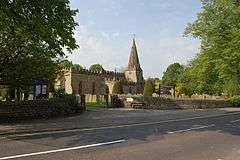Baslow
| Baslow | |
 Parish church |
|
 Baslow |
|
| Population | 1,100 |
|---|---|
| OS grid reference | SK252723 |
| Civil parish | Baslow and Bubnell |
| District | Derbyshire Dales |
| Shire county | Derbyshire |
| Region | East Midlands |
| Country | England |
| Sovereign state | United Kingdom |
| Post town | BAKEWELL |
| Postcode district | DE45 |
| Police | Derbyshire |
| Fire | Derbyshire |
| Ambulance | East Midlands |
| EU Parliament | East Midlands |
| UK Parliament | Derbyshire Dales |
|
|
Coordinates: 53°14′53″N 1°37′23″W / 53.248°N 1.623°W
 |
Pronounced
(listen) |
| Problems playing this file? See media help. | |
Baslow is a village in Derbyshire, England, in the Peak District, lying between Sheffield and Bakewell. It is situated on the River Derwent just north of Chatsworth House. The river is spanned by a 17th-century bridge, alongside which is a contemporary toll house.
Different parts of the built-up area of Baslow are named as Bubnell (west of the river), Bridge End (by the river crossings), Over End (north of the main road) and Nether End (adjacent to Chatsworth Park).[1] The village's civil parish is called Baslow and Bubnell, and has a population of approximately 1,100.[2]
Bridge End
Bridge End is the original settlement, clustered around St. Anne's Church, Baslow and the ancient bridge and ford across the River Derwent. The church boasts a Saxon coffin lid in the porch entrance, but the oldest part of the current building, the north aisle, dates from about 1200. The tower was constructed in the 13th century but the rest of the church is newer and was the subject of an extensive restoration in the 19th century.
A sundial lies in the church grounds, atop the shaft, base and steps of a cross. This may have acted as a market cross in the 17th century. A second cross lies in the graveyard, moved from Bubnell by Doctor Wrench, who erected the nearby Wellington Monument and is buried in the churchyard. This cross may historically have been known as the "Butter Cross".[3]
Just behind the church lies the old bridge. Built in 1603, this is the oldest bridge across the Derwent never to have been destroyed by floods.

Nether End
The eastern end of the village is called Nether End and contains an entrance to Chatsworth Park. The area is popular with tourists and visitors to the village because of a concentration of hotels, pubs and restaurants, tea rooms, a caravan site and a pedestrian entrance to Chatsworth Park. Just outside Nether End (and the village itself) are the so-called "Golden Gates", a set of gates dating from the 1st Duke's rebuilding of Chatsworth, which were moved here by Sir Joseph Paxton for William Cavendish, 6th Duke of Devonshire, in the 19th century to make a new entrance to the park, following its extension northwards towards Baslow in the 1830s. The gates are now only rarely used, most usually when large public events are held in the park.
Over End
The third area of Baslow is called Over End and is a residential area on the hillside to the north of the village. Its primary feature of interest is Baslow Hall, just off Calver Road, which was once occupied by Sebastian Ziani de Ferranti, the radio and electrical pioneer and inventor, and next by George Kenning. Today it is Fischer's Restaurant. Near the junction of Bar Road and Gorse Bank Lane was the site of a large Hydropathic hotel, which was demolished in 1936 and is now a small cul-de-sac called Hydro Close.
The Baslow Grand Hotel Golf Club (now defunct) was founded in 1896. The course was still appearing on Ordnance Survey maps in the 1930s.[4]
Outside the village
The edges around Baslow, such as Froggatt Edge, offer fine walking and rock climbing, with splendid views over the Derwent valley. To the north of the village, Baslow Edge was once quarried for gritstone and features the Eagle Stone, an isolated 6-metre high block of gritstone. Tradition has it that the local men had to climb this rock before they were worthy of marriage. Just behind it there is a monument to the Duke of Wellington, raised in 1866 by the local dignatory, Dr Lieutenant Colonel E. M. Wrench. It marked an earlier visit by Wellington to the moor, and was also intended as a balance to the nearby Nelson Monument.[3]
Notable residents
- Frederic Barker was born here and was vicar here before being Bishop of Sydney.[5]
- Former England cricket captain Michael Vaughan lives here.
- Dr E.M. Wrench's papers are held by the department of Manuscripts and Special Collections, The University of Nottingham.
References
- ↑ Ordnance Survey (1989), 1:50,000 Landranger Series, Sheet 119 (Buxton, Matlock & Dove Dale area), ISBN 0-319-22119-9
- ↑ District Education site
- 1 2 Sharpe, Neville T. (2002). Crosses of the Peak District. Ashbourne: Landmark Collectors Library. ISBN 1843060442.
- ↑ “Baslow Grand Hotel Golf Club”, “Golf’s Missing Links”.
- ↑ Serle, Percival (1949). "Barker, Frederic". Dictionary of Australian Biography. Sydney: Angus and Robertson.
External links
| Wikimedia Commons has media related to Baslow. |
- Baslow description page from Discover Derbyshire
- Baslow walk from Discover Derbyshire
- Baslow section of genuki.org.uk
- Baslow in the Domesday Book